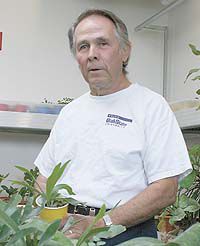| Jerry Anderson stands with many of the plants that are growing in the CEU greenhouse, which is situated in the new Reeves Building. Some of the plants shown are for the new Mesozoic Gardens that will be built in conjunction with the CEU Prehistoric Museum on the ridge above Castleview Hospital.
|
Jerry Anderson’s kids have told him a number of times he is over the hill.
But at 72 years old he is not only over the hill, but around the hill, behind the hill and even on top of the hill.
With a passion for science since he was a kid, and a particular interest in botany, Anderson still pursues his passion for plants well past the time most people would be worrying about such things.
A science teacher by trade, he has gathered hundreds of plant samples over the years and even holds some kinds of records for the kinds of flora he has collected.
“I have collected more grasses than any other person in Utah,” he said proudly as he stood in the herbarium at the College of Eastern Utah.
But his passions for plants also extends to other things. Being a science teacher with a bachelors from the University of Utah and masters degree from BYU, his interests are varied and diverse. He is a collector of coins and postage stamps, he is a beekeeper, a photographer, a potter and sculptor and is a skilled outdoors man as well.
| A plant press (on the left) is used to create the sample sheets that researchers can use at a later date to examine plant species. Plants are mounted on sheets like those on the table (right) for further reference. |
In fact, the outdoors is where he excels and it is also where the plants come in.
For instance, recently he climbed the highest peak in Utah (13,528 feet) to do some collecting for the herbarium at CEU. While over 5000 people climb that peak each year, it is still quite a feat for someone his age.
“When I was a kid I got some guys together and we decided that we were going to climb four peaks in the Unita’s all in one day,” he said. “That day we were going to do it, everyone else decided that it wasn’t for them, but I still decided to do it.”
He did the entire trek in less than eight hours.
Anderson, who is originally from Salt Lake, ended up in eastern Utah in kind of a strange way; he heard an announcement in Sanpete county while he was driving through that coal miners were needed in Emery County. That was in 1979 and he wanted to do something different so he became a coal miner. He worked for a short time at the Wilberg Mine and decided instead he still wanted to teach. So he began working locally and ended up at Harrier High School (the alternative school that used to be in the old Reeves School building in Price).
Overall Anderson has taught at a number of places. He worked in Wyoming for many years, taught in California and Arizona and eventually did instruction at what is known as Utah Valley State College now.
But probably some of his best experiences teaching was the years he spent in Australia teaching. As a botanist he had a ball there, because the plant life is so unique and diverse.
“People used to bring me plant samples and have me help them figure out what they were,” he said. “One time a local police officer came to me with some leaves and said that during an operation someone had passed the plant along as marijuana. He said he had some bad weed. They were actually tomato plant leaves.”
| Hanging files are used to store the samples that have been pressed and mounted. Future researchers will appreciate the samples and will be able to use them in further research. |
Anderson has received a number of honors during his life. He has accepted awards for being the outstanding biology teacher of the year, a Krista McAuliffe fellowship award and international teaching fellowship. He has also served on the board of the Utah Science Teacher Association.
Presently he is on the adjunct faculty at CEU and teaches a botany class periodically. Over his teaching years he has instructed students in not only biology and botany, but also in chemistry, geology, human anatomy/physiology and microbiology.
For now though he would like to continue to teach botany, which he says he is fascinated by.
To accomplish the collection of species, however, takes more than just picking flowers. It takes collecting them properly, then preserving them for others to utilize.
Once Anderson has collected what he finds, he brings it back to the herbarium and there he prepares it and puts the samples in a press. They are then mounted on thin cardboard stock, with a notation as to what they are, where they were collected and who collected them. They are then filed in a special filing case for future reference.
In his travels into the wild Anderson sees a lot of things going on and that is where his photography skills come in.
Over the hill? Well maybe according to his kids (and some of his 62 grandchildren). But he is over the hill doing some pretty important work.

